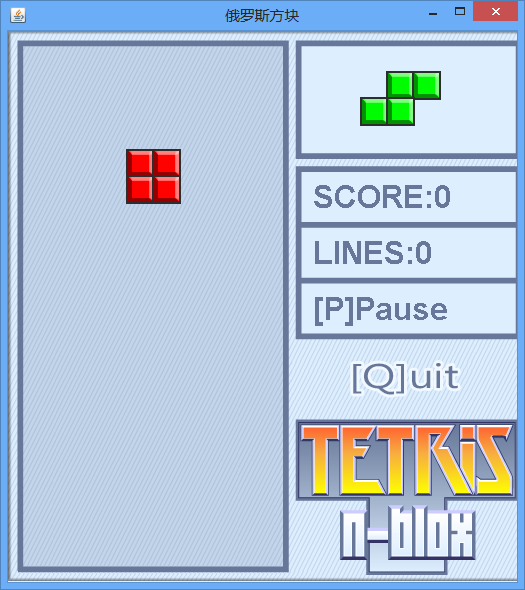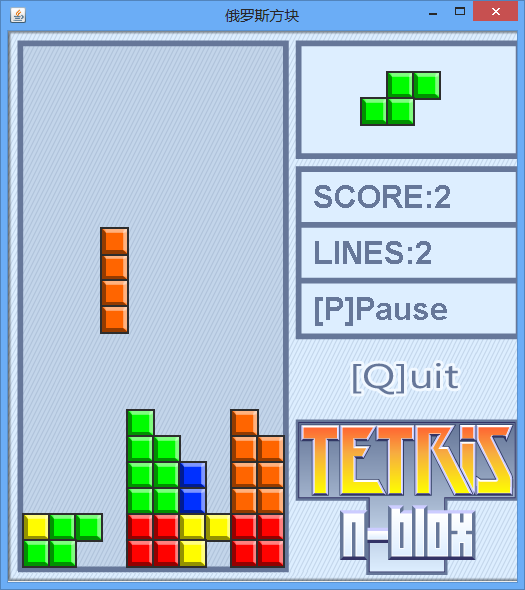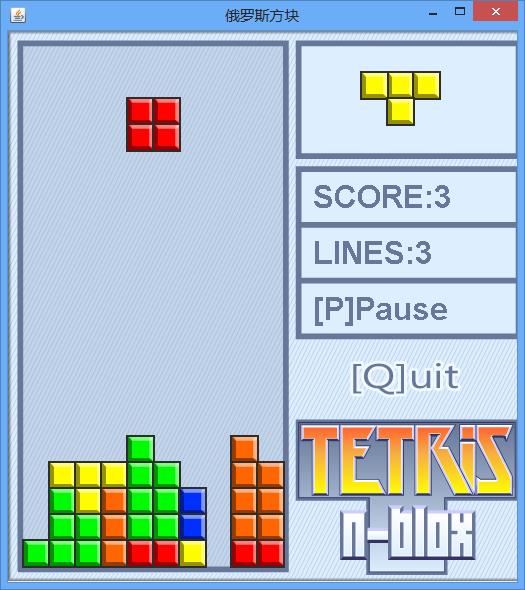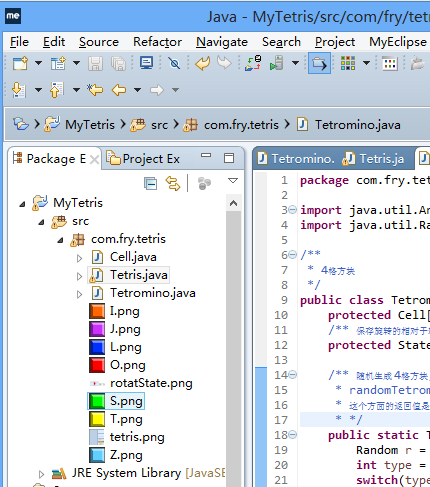java项目 俄罗斯方块
一、心得
二、游戏实例
游戏截图



目录结构

三、代码
1、主界面 tetris.java
|
1
2
3
4
5
6
7
8
9
10
11
12
13
14
15
16
17
18
19
20
21
22
23
24
25
26
27
28
29
30
31
32
33
34
35
36
37
38
39
40
41
42
43
44
45
46
47
48
49
50
51
52
53
54
55
56
57
58
59
60
61
62
63
64
65
66
67
68
69
70
71
72
73
74
75
76
77
78
79
80
81
82
83
84
85
86
87
88
89
90
91
92
93
94
95
96
97
98
99
100
101
102
103
104
105
106
107
108
109
110
111
112
113
114
115
116
117
118
119
120
121
122
123
124
125
126
127
128
129
130
131
132
133
134
135
136
137
138
139
140
141
142
143
144
145
146
147
148
149
150
151
152
153
154
155
156
157
158
159
160
161
162
163
164
165
166
167
168
169
170
171
172
173
174
175
176
177
178
179
180
181
182
183
184
185
186
187
188
189
190
191
192
193
194
195
|
package com.fry.tetris;import java.util.arrays;import java.util.random;/** * 4格方块 */public class tetromino { protected cell[] cells = new cell[4]; /** 保存旋转的相对于轴位置状态 */ protected state[] states; /** 随机生成 4格方块, 使用简单工厂方法模式! * randomtetromino 随机生成一个四格方块 * 这个方面的返回值是多态的! * */ public static tetromino randomtetromino(){ random r = new random(); int type = r.nextint(7); switch(type){ case 0: return new t(); case 1: return new i(); case 2: return new j(); case 3: return new l(); case 4: return new o(); case 5: return new s(); case 6: return new z(); } return null; } public cell[] getcells() { return cells; } /** 下落 */ public void softdrop(){ for(int i=0; i<cells.length; i++){ cells[i].movedown(); } } public void moveright(){ //system.out.println("moveright()"); for(int i=0; i<cells.length; i++){ this.cells[i].moveright(); } } public void moveleft(){ for(int i=0; i<cells.length; i++){ cells[i].moveleft(); } } private int index = 100000; /** 在 tetromino 上添加方法 */ public void rotateright() { index++;//index = 10001 // index % states.length = 10001 % 4 = 1 state s = states[index%states.length];//s1 // [0] + s1 = [1] cell o = cells[0];//获取当前的轴 //轴与相对位置的和作为旋转以后的格子位置 cells[1].setrow(o.getrow()+s.row1); cells[1].setcol(o.getcol()+s.col1); cells[2].setrow(o.getrow()+s.row2); cells[2].setcol(o.getcol()+s.col2); cells[3].setrow(o.getrow()+s.row3); cells[3].setcol(o.getcol()+s.col3); } /** 在 tetromino 上添加方法 */ public void rotateleft() { index--;//index = 10001 // index % states.length = 10001 % 4 = 1 state s = states[index%states.length];//s1 // [0] + s1 = [1] cell o = cells[0];//获取当前的轴 cells[1].setrow(o.getrow()+s.row1); cells[1].setcol(o.getcol()+s.col1); cells[2].setrow(o.getrow()+s.row2); cells[2].setcol(o.getcol()+s.col2); cells[3].setrow(o.getrow()+s.row3); cells[3].setcol(o.getcol()+s.col3); } @override public string tostring() { return arrays.tostring(cells); } /** tetromino 类中添加的 内部类 用于记录旋转状态 */ protected class state{ int row0,col0,row1,col1,row2,col2,row3,col3; public state(int row0, int col0, int row1, int col1, int row2, int col2, int row3, int col3) { this.row0 = row0; this.col0 = col0; this.row1 = row1; this.col1 = col1; this.row2 = row2; this.col2 = col2; this.row3 = row3; this.col3 = col3; } } }//tetromino 类的结束class t extends tetromino{ public t() { cells[0] = new cell(0, 4, tetris.t); cells[1] = new cell(0, 3, tetris.t); cells[2] = new cell(0, 5, tetris.t); cells[3] = new cell(1, 4, tetris.t); states = new state[]{ new state(0,0, 0,-1, 0,1, 1, 0), new state(0,0, -1,0, 1,0, 0,-1), new state(0,0, 0,1, 0,-1, -1,0), new state(0,0, 1,0, -1,0, 0,1)}; }}class i extends tetromino{ public i() { cells[0] = new cell(0, 4, tetris.i); cells[1] = new cell(0, 3, tetris.i); cells[2] = new cell(0, 5, tetris.i); cells[3] = new cell(0, 6, tetris.i); states = new state[]{ new state(0,0, 0,1, 0,-1, 0,-2), new state(0,0, -1,0, 1,0,2,0)}; }}class l extends tetromino { public l() { cells[0] = new cell(0, 4, tetris.l); cells[1] = new cell(0, 3, tetris.l); cells[2] = new cell(0, 5, tetris.l); cells[3] = new cell(1, 3, tetris.l); states = new state[]{ new state(0,0, 0,-1, 0,1, 1,-1 ), new state(0,0, -1,0, 1,0, -1,-1), new state(0,0, 0,1, 0,-1, -1,1), new state(0,0, 1,0, -1,0, 1,1)}; }}class j extends tetromino { public j() { cells[0] = new cell(0, 4, tetris.j); cells[1] = new cell(0, 3, tetris.j); cells[2] = new cell(0, 5, tetris.j); cells[3] = new cell(1, 5, tetris.j); states = new state[]{ new state(0,0, 0,-1, 0,1, 1,1), new state(0,0, -1,0, 1,0, 1,-1), new state(0,0, 0,1, 0,-1, -1,-1), new state(0,0, 1,0, -1,0, -1,1 )}; }}class s extends tetromino { public s() { cells[0] = new cell(0, 4, tetris.s); cells[1] = new cell(0, 5, tetris.s); cells[2] = new cell(1, 3, tetris.s); cells[3] = new cell(1, 4, tetris.s); states = new state[]{ new state(0,0, 0,1, 1,-1, 1,0 ), new state(0,0, -1,0, 1,1, 0,1 )}; }}class z extends tetromino { public z() { cells[0] = new cell(1, 4, tetris.z); cells[1] = new cell(0, 3, tetris.z); cells[2] = new cell(0, 4, tetris.z); cells[3] = new cell(1, 5, tetris.z); states = new state[]{ new state(0,0, -1,-1, -1,0, 0,1 ), new state(0,0, -1,1, 0,1, 1,0 )}; }}class o extends tetromino { public o() { cells[0] = new cell(0, 4, tetris.o); cells[1] = new cell(0, 5, tetris.o); cells[2] = new cell(1, 4, tetris.o); cells[3] = new cell(1, 5, tetris.o); states = new state[]{ new state(0,0, 0,1, 1,0, 1,1 ), new state(0,0, 0,1, 1,0, 1,1 )}; }} |
二、cell.java
|
1
2
3
4
5
6
7
8
9
10
11
12
13
14
15
16
17
18
19
20
21
22
23
24
25
26
27
28
29
30
31
32
33
34
35
36
37
38
39
40
41
42
43
44
45
46
47
48
49
50
51
52
53
54
55
56
57
58
59
60
61
62
63
64
65
66
67
|
package com.fry.tetris;import java.awt.image;/** * 格子 * 每一个小格子,就有所在的行 列 和图片 */public class cell { private int row; private int col; //private int color; private image image;//格子的贴图 public cell() { } public cell(int row, int col, image image) { super(); this.row = row; this.col = col; this.image = image; } public int getrow() { return row; } public void setrow(int row) { this.row = row; } public int getcol() { return col; } public void setcol(int col) { this.col = col; } public image getimage() { return image; } public void setimage(image image) { this.image = image; } public void moveright(){ col++; //system.out.println("cell moveright()" + col); } public void moveleft(){ col--; } public void movedown(){ row++; } @override public string tostring() { return "["+row+","+col+"]"; }} |
三、功能实现 tetromino.java
|
1
2
3
4
5
6
7
8
9
10
11
12
13
14
15
16
17
18
19
20
21
22
23
24
25
26
27
28
29
30
31
32
33
34
35
36
37
38
39
40
41
42
43
44
45
46
47
48
49
50
51
52
53
54
55
56
57
58
59
60
61
62
63
64
65
66
67
68
69
70
71
72
73
74
75
76
77
78
79
80
81
82
83
84
85
86
87
88
89
90
91
92
93
94
95
96
97
98
99
100
101
102
103
104
105
106
107
108
109
110
111
112
113
114
115
116
117
118
119
120
121
122
123
124
125
126
127
128
129
130
131
132
133
134
135
136
137
138
139
140
141
142
143
144
145
146
147
148
149
150
151
152
153
154
155
156
157
158
159
160
161
162
163
164
165
166
167
168
169
170
171
172
173
174
175
176
177
178
179
180
181
182
183
184
185
186
187
188
189
190
191
192
193
194
195
|
package com.fry.tetris;import java.util.arrays;import java.util.random;/** * 4格方块 */public class tetromino { protected cell[] cells = new cell[4]; /** 保存旋转的相对于轴位置状态 */ protected state[] states; /** 随机生成 4格方块, 使用简单工厂方法模式! * randomtetromino 随机生成一个四格方块 * 这个方面的返回值是多态的! * */ public static tetromino randomtetromino(){ random r = new random(); int type = r.nextint(7); switch(type){ case 0: return new t(); case 1: return new i(); case 2: return new j(); case 3: return new l(); case 4: return new o(); case 5: return new s(); case 6: return new z(); } return null; } public cell[] getcells() { return cells; } /** 下落 */ public void softdrop(){ for(int i=0; i<cells.length; i++){ cells[i].movedown(); } } public void moveright(){ //system.out.println("moveright()"); for(int i=0; i<cells.length; i++){ this.cells[i].moveright(); } } public void moveleft(){ for(int i=0; i<cells.length; i++){ cells[i].moveleft(); } } private int index = 100000; /** 在 tetromino 上添加方法 */ public void rotateright() { index++;//index = 10001 // index % states.length = 10001 % 4 = 1 state s = states[index%states.length];//s1 // [0] + s1 = [1] cell o = cells[0];//获取当前的轴 //轴与相对位置的和作为旋转以后的格子位置 cells[1].setrow(o.getrow()+s.row1); cells[1].setcol(o.getcol()+s.col1); cells[2].setrow(o.getrow()+s.row2); cells[2].setcol(o.getcol()+s.col2); cells[3].setrow(o.getrow()+s.row3); cells[3].setcol(o.getcol()+s.col3); } /** 在 tetromino 上添加方法 */ public void rotateleft() { index--;//index = 10001 // index % states.length = 10001 % 4 = 1 state s = states[index%states.length];//s1 // [0] + s1 = [1] cell o = cells[0];//获取当前的轴 cells[1].setrow(o.getrow()+s.row1); cells[1].setcol(o.getcol()+s.col1); cells[2].setrow(o.getrow()+s.row2); cells[2].setcol(o.getcol()+s.col2); cells[3].setrow(o.getrow()+s.row3); cells[3].setcol(o.getcol()+s.col3); } @override public string tostring() { return arrays.tostring(cells); } /** tetromino 类中添加的 内部类 用于记录旋转状态 */ protected class state{ int row0,col0,row1,col1,row2,col2,row3,col3; public state(int row0, int col0, int row1, int col1, int row2, int col2, int row3, int col3) { this.row0 = row0; this.col0 = col0; this.row1 = row1; this.col1 = col1; this.row2 = row2; this.col2 = col2; this.row3 = row3; this.col3 = col3; } } }//tetromino 类的结束class t extends tetromino{ public t() { cells[0] = new cell(0, 4, tetris.t); cells[1] = new cell(0, 3, tetris.t); cells[2] = new cell(0, 5, tetris.t); cells[3] = new cell(1, 4, tetris.t); states = new state[]{ new state(0,0, 0,-1, 0,1, 1, 0), new state(0,0, -1,0, 1,0, 0,-1), new state(0,0, 0,1, 0,-1, -1,0), new state(0,0, 1,0, -1,0, 0,1)}; }}class i extends tetromino{ public i() { cells[0] = new cell(0, 4, tetris.i); cells[1] = new cell(0, 3, tetris.i); cells[2] = new cell(0, 5, tetris.i); cells[3] = new cell(0, 6, tetris.i); states = new state[]{ new state(0,0, 0,1, 0,-1, 0,-2), new state(0,0, -1,0, 1,0,2,0)}; }}class l extends tetromino { public l() { cells[0] = new cell(0, 4, tetris.l); cells[1] = new cell(0, 3, tetris.l); cells[2] = new cell(0, 5, tetris.l); cells[3] = new cell(1, 3, tetris.l); states = new state[]{ new state(0,0, 0,-1, 0,1, 1,-1 ), new state(0,0, -1,0, 1,0, -1,-1), new state(0,0, 0,1, 0,-1, -1,1), new state(0,0, 1,0, -1,0, 1,1)}; }}class j extends tetromino { public j() { cells[0] = new cell(0, 4, tetris.j); cells[1] = new cell(0, 3, tetris.j); cells[2] = new cell(0, 5, tetris.j); cells[3] = new cell(1, 5, tetris.j); states = new state[]{ new state(0,0, 0,-1, 0,1, 1,1), new state(0,0, -1,0, 1,0, 1,-1), new state(0,0, 0,1, 0,-1, -1,-1), new state(0,0, 1,0, -1,0, -1,1 )}; }}class s extends tetromino { public s() { cells[0] = new cell(0, 4, tetris.s); cells[1] = new cell(0, 5, tetris.s); cells[2] = new cell(1, 3, tetris.s); cells[3] = new cell(1, 4, tetris.s); states = new state[]{ new state(0,0, 0,1, 1,-1, 1,0 ), new state(0,0, -1,0, 1,1, 0,1 )}; }}class z extends tetromino { public z() { cells[0] = new cell(1, 4, tetris.z); cells[1] = new cell(0, 3, tetris.z); cells[2] = new cell(0, 4, tetris.z); cells[3] = new cell(1, 5, tetris.z); states = new state[]{ new state(0,0, -1,-1, -1,0, 0,1 ), new state(0,0, -1,1, 0,1, 1,0 )}; }}class o extends tetromino { public o() { cells[0] = new cell(0, 4, tetris.o); cells[1] = new cell(0, 5, tetris.o); cells[2] = new cell(1, 4, tetris.o); cells[3] = new cell(1, 5, tetris.o); states = new state[]{ new state(0,0, 0,1, 1,0, 1,1 ), new state(0,0, 0,1, 1,0, 1,1 )}; }} |
以上就是java实现俄罗斯方块的实例,如有疑问请留言或者到本站社区讨论,感谢阅读,希望能帮助到大家,谢谢大家对本站的支持!
原文链接:http://www.cnblogs.com/Renyi-Fan/p/7220327.html











